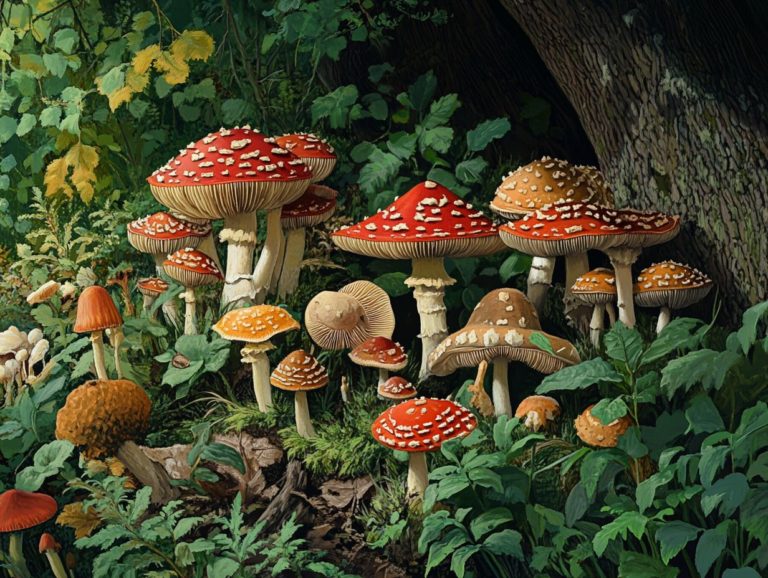What Edible Plants Can I Forage in Winter?
Winter may seem like a desolate season, but it offers a fantastic opportunity for those eager to uncover nature s hidden treasures.
This guide explores the many benefits of winter foraging from its health perks to its positive impact on the environment. You will discover common edible plants that thrive in colder months, crucial safety precautions, and practical tips to enhance your foraging experience.
Embark on this journey and uncover the abundant treasures that winter has to offer!
Contents
Key Takeaways:

- Winter foraging connects you to nature while providing nutritional and environmental benefits.
- Common edible plants to forage during winter include wintergreen, wild garlic, and rose hips.
- Safety and proper plant identification are essential for a successful and safe winter foraging experience.
What is Winter Foraging?
Winter foraging is the practice of searching for and gathering wild edible plants, mushrooms, and other natural treasures during the colder months. It’s an incredible chance to engage with nature and discover what edibles can be foraged in wetlands that winter offers.
To master this essential skill, familiarize yourself with the edible and health benefits of various plants, such as conifer needles, wintergreen leaves, and tree sap. This knowledge can enhance your culinary adventures and personal well-being. You will also learn about wildcrafting gathering plants responsibly and foraging for edible berries, deepening your appreciation for seasonal ecosystems.
As the landscape transforms under a blanket of snow, you access a wealth of knowledge that highlights the importance of adapting to the seasons. Techniques like identifying edible fungi, looking for hearty roots, and interpreting animal trails sharpen your foraging skills while nurturing a deep connection to the environment.
Winter foraging is not just a skill; it’s a time-honored tradition that connects you to your ancestors and celebrates the art of harvesting.
This practice promotes sustainability, allowing you to gather resources with minimal ecological impact compared to commercial farming. Ultimately, this journey benefits your health through the enjoyment of natural, nutrient-rich foods.
Benefits of Foraging in Winter
Foraging in winter provides numerous benefits that encompass nutritional, health, and environmental aspects, making it an enriching activity for those looking to reconnect with nature and boost their well-being through wild edible plants.
Engaging in this practice gives you access to nutritious food sources when fresh produce is scarce. It also reveals the health benefits found in various plants, such as Oregon Grape and Dandelion. This journey contributes to your overall wellness while increasing your appreciation for the environment around you.
Nutritional and Environmental Benefits
The nutritional and environmental benefits of winter foraging are truly remarkable. Wild edible plants like dandelion and wintergreen provide essential vitamins and minerals while fostering environmental stewardship through sustainable harvesting practices.
By embracing a variety of wild greens, such as Chicory and edible mushrooms, you can improve your health while significantly reducing your ecological footprint.
These wild edibles enrich your diet with vital nutrients like Vitamin C and fiber, fostering a deeper connection with your local ecosystems. Take stinging nettle, for example: often overlooked, this powerhouse is packed with iron and acts as a natural anti-inflammatory. Engaging in foraging not only enhances biodiversity but also cultivates an appreciation for native plant species.
However, it’s critical to forage responsibly. Avoid overharvesting and ensure the environment remains undisturbed, especially when gathering tree sap or edible seaweed. By being mindful of the ecological impact of your actions particularly when harvesting nuts and seeds you can enjoy nature s bounty while actively supporting the health of our planet.
Start your winter foraging adventure today!
Common Edible Plants in Winter

You’ll find many common edible plants like Hawthorn Berries and Cranberries can be foraged during winter, as explored in what wild edibles are available year-round. This presents a unique opportunity to embrace the seasonal bounty.
You can also find conifer trees, which offer a variety of edible components, including conifer needles and tree sap. In addition, winter foraging reveals wintergreen leaves, wild edible berries, and an array of herbal plants that await your discovery, enriching both your foraging experience and your meals throughout the colder months.
Getting to know these plants is exciting and crucial for safe and effective foraging. This knowledge allows you to savor the gifts of the season.
Identifying and Harvesting Edible Plants
Identifying and harvesting edible plants is an essential skill for winter foraging, requiring careful observation to differentiate between various species. This includes edible mushrooms like Chaga Fungus and Turkey Tail Mushroom, along with edible berries that flourish in winter.
Mastering ways to recognize different plants not only ensures safe foraging but also enriches your experience. You ll learn to appreciate the diverse array of edible plants, including Juniper Berries and conifer needles, that winter has to offer.
This journey requires careful observation and significant investment in research and experience to spot subtle differences between similar-looking species. Understanding the habitat and growth patterns of specific plants, such as wild leeks, and recognizing their nutritional benefits can enhance your foraging expertise.
Experienced foragers emphasize the importance of sustainable harvesting practices, meaning only taking what you need and ensuring plants can continue to grow. By utilizing resources like field guides and participating in local foraging groups, you can refine your skills. This paves the way for a safe and rewarding foraging adventure, even in the chill of winter.
Safety Precautions for Winter Foraging
Don t underestimate safety during winter foraging your adventure depends on it! It’s crucial to shield yourself from the cold and other potential hazards while seeking wild edible plants.
By recognizing possible risks and employing effective foraging techniques, you can ensure your safety and comfort. This allows you to fully appreciate the bounty of edible mushrooms, berries, and medicinal plants the winter landscape offers.
Protecting Against Cold and Other Hazards
Protecting yourself against the cold and other hazards is essential when you engage in winter foraging. With the right clothing, gear, and awareness of your environment, you can significantly enhance both safety and comfort.
Layering is your best friend; moisture-wicking base layers, insulating mid-layers, and waterproof outer layers work together to help regulate your body temperature while foraging. Sturdy, insulated footwear is essential for maintaining traction on slippery surfaces, while accessories like gloves, hats, and scarves shield your extremities from chilling winds.
Before you head out, always check the weather forecasts and prepare an emergency kit that includes snacks, water, and a first-aid kit. Being aware of your surroundings is equally important spotting hazards like hidden holes in the snow or recognizing the potential for avalanches can prevent accidents and ensure your foraging adventure is both safe and successful.
Tips for Finding Edible Plants in Winter

Finding edible plants in winter can be challenging. However, with the right tips, you can enhance your success and enjoyment during these colder months.
Joining a winter foraging course equips you with essential skills. Learning to identify key wild edible plants increases your chances of a fruitful foraging experience.
Strategies for Successful Foraging
Using smart strategies is key to gathering wild edible plants in winter. Understanding plant habitats, like those of juniper berries and acorns, will guide your foraging efforts.
Your observation skills are crucial for spotting edible plants beneath the snow. Knowing local ecosystems helps you find promising foraging spots.
Understanding seasonal patterns improves your success rate. It also informs you about the best times to harvest sustainably, ensuring you don t deplete natural supplies.
Leaving some berries and nuts behind encourages regeneration. This practice shows how we can take care of nature.
Frequently Asked Questions
What Edible Plants Can I Forage in Winter?
Foraging isn’t just for summer. You can find several edible plants in winter, including:
- Wintergreen
- Chickweed
- Burdock Root
- Dandelion Greens
- Nettles
- Cattail
How can I spot edible plants in winter?

Winter foraging can be tricky, but you can still spot edible plants. Look for plants with distinctive smells, like wintergreen and burdock root, or those with unique features like cattail. For more insights, check out wild edibles to forage in winter.
Research pictures and descriptions of these plants before heading out to forage.
What precautions should I take when foraging in winter?
Yes, caution is crucial during winter foraging. Dress warmly to prevent cold-related dangers like hypothermia.
Always make sure to identify plants correctly before eating them. Avoid collecting from areas treated with pesticides or chemicals.
Can I eat all parts of these plants?
Most parts of these plants are safe to eat, but do your homework first. For instance, with burdock root, only the root is edible, while dandelion greens include the leaves and flowers.
Can I find these plants in all regions?
These plants are often found in many parts of North America and Europe. Research the specific plants in your area, as some may only grow in certain climates.
What are other tips for foraging in winter?
Forage responsibly this winter. Only take what you need and leave enough for plants to keep growing.
Properly clean and prepare your foraged plants before consumption.






